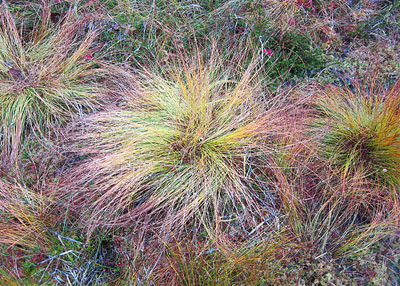Fall colors the muskeg on Alaska’s Tongass National Forest

Shore pines (Pinus contorta subsp. contorta) add punctuations of green to this muskeg near Sitka, Alaska. Pines growing in muskegs are stunted and very old. Tufted bulrush (Trichophorum caespitosum) plants are a dominant ground cover in this part of the muskeg and add color as their foliage turns orange and brown in the autumn. Flecks of red in the foreground are the scarlet foliage of dwarf dogwood (Cornus suecica).
Photo credit: Mary Stensvold
Posted by: Mary Stensvold, U.S. Forest Service Regional Botanist, Sitka, Alaska
Muskegs, a colloquial term for peat bogs, blanket 10 percent of the Tongass National Forest. These wetlands range in size from a few square feet to many acres. Over the ages, muskegs formed as Sphagnum mosses, rushes and sedges grew and built up spongy carpets in these very wet, almost treeless areas.
The few species of plants that thrive in muskegs are tolerant of the acidic, supersaturated soil. Low-growing evergreen shrubs, such as Labrador tea (Ledum groenlandicum), bog laurel (Kalmia polifolia), bog rosemary (Andromeda polifolia), crowberry (Empetrum nigrum), bog blueberry (Vaccinium uliginosum), dwarf blueberry(V. caespitosum) and cloudberry (Rubus chamaemorus) are abundant. Occasional irregularly sized pools and a few gnarled, stunted shore pines (Pinus contorta subsp. contorta) break the hummocky carpet of low vegetation.
During the early summer, colorful arrays of flowers, such as bog orchids (Platanthera species), Jeffery shooting star (Dodecatheon jeffreyi), yellow pond lily (Nuphar lutea subsp. polysepala), swamp gentian (Gentiana douglasiana), and dwarf dogwood, sometimes called Lapland cornel, (Cornus suecica) enliven the muskegs.
With the onset of autumn, a blaze of colors erupt in the muskegs as the foliage transitions from summer green to autumn yellows, oranges and reds. The colors are particularly impressive with the coniferous trees of adjacent forests providing deep green backdrops.(Note: The accompanying photos were taken in a muskeg behind the town of Sitka, Alaska, adjacent to the Tongass National Forest. To locate this muskeg in a mapping application, such as Google Earth, paste in this latitude and longitude: 57° 3'26.73"N, 135°19'49.22"W. °)

A clump of tufted bulrush (Trichophorum caespitosum) shows the progression of fall color change in a muskeg near Sitka.
Photo by Mary Stensvold

